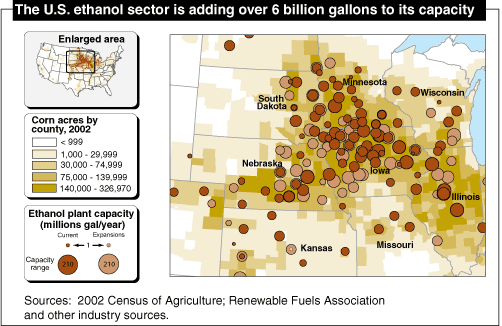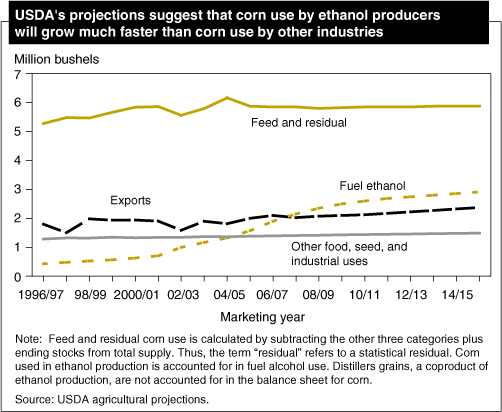Ethanol Reshapes the Corn Market
Warning: Undefined variable $tagger in /var/www/bioenergypro.com/public_html/bioenergy-articles/snews.php on line 2924
Warning: Undefined array key "https://www.bioenergypro.com/bioenergy-articles/Logged_In" in /var/www/bioenergypro.com/public_html/bioenergy-articles/snews.php on line 2999
The expanding U.S. ethanol sector is stimulating demand for corn, but alternatives to corn may dampen that demand.
The last 2 years were marked by a flurry of construction activity in the U.S. ethanol industry, as ground was broken on dozens of new plants throughout the Corn Belt and plans were drawn for even more facilities. As of February 2007, the annual capacity of the U.S. ethanol sector stood at 5.6 billion gallons, and plants under construction or expansion are likely to add another 6.2 billion gallons to this number (map). If this trend and the existing and anticipated policy incentives in support of ethanol continue, U.S. ethanol production could easily reach 11 billion gallons in 2011, 7.3 billion more than the amount produced in 2005.
The tremendous expansion of the ethanol sector raises a key question: Where will ethanol producers get the corn needed to increase their output? With a corn-to-ethanol conversion rate of 2.7 gallons per bushel (a rate that many state-of-the-art facilities are already surpassing), the U.S. ethanol sector will need 4 billion bushels per year by 2011—roughly twice as much as it consumed in 2006. That’s a lot of corn, and how the market adapts to this increased demand is likely to be one of the major developments of the early 21st century in U.S. agriculture. The most recent USDA projections suggest that much of the additional corn needed for ethanol production will be diverted from exports and feed. However, if the United States successfully develops cellulosic biomass (e.g., wood fibers and crop residues) as an economical alternative feedstock for ethanol production, corn would become one of many crops and plant-based materials used to produce ethanol.
Large corn stocks will enable U.S. ethanol production to increase initially without requiring much additional adjustment in the corn market. The U.S. ended the 2005/06 Marketing Year (MY—September 2005-August 2006) with stocks of 2.0 billion bushels, enough to produce 5.3 billion gallons of ethanol, and ending stocks declined by only 143 million bushels between MYs 2004/05 and 2005/06. As long as corn is the primary feedstock for ethanol in the U.S., however, sustained increases in ethanol production will eventually require major adjustments in the corn market.
One possibility is that ethanol producers will secure the additional corn they need by competing with other buyers in the marketplace and bidding up the price of corn. Already, there are signs that this is happening in the spot and futures markets. According to the USDA projections (released in February 2007), the share of ethanol in total corn use will rise from 14 percent in 2005/06 to 31 percent in 2016/17. A comparison of the 2007 projections with the 2005 Baseline suggests that much of the increased use by ethanol producers will be diverted from potential exports; the 2007 projections suggest much higher use for ethanol and lower exports than the 2005 Baseline. Corn may also be diverted from feed use.

If demand for ethanol reduces the availability of U.S. corn for export, one might ask how this will alter the geographical composition of U.S. exports. The 2006 Baseline suggests that among the major foreign buyers of U.S. corn, Japan and Taiwan are likely to be the least responsive to a rise in corn prices, while Canada, Egypt, and the Central American and Caribbean region are likely to be the most responsive. Japan and Taiwan both have relatively high per capita incomes and limited corn production. In contrast, Canada, another high-income country, has substantial levels of corn production and could respond to higher prices with increased output of corn, wheat, and other feed grains. Per capita income in Egypt, Central America, and the Caribbean is relatively low, and higher prices may drive these countries to cut back in corn use, increase domestic corn production, or seek out substitutes. Egypt already produces a sizable amount of corn.
Slower growth of U.S. corn exports would create new opportunities for corn producers in other parts of the world, including Argentina, Brazil, and China. Another country to watch is Mexico, where the price of tortillas increased by roughly 50 percent between June 2006 and January 2007 due in part to greater tightness in the international corn market. Irrigated lands account for about half of the increase in Mexican corn production since the late 1980s. Much of this increase has taken place in the State of Sinaloa, where farmers are applying advanced agricultural techniques to obtain yields comparable to those in the United States. Sinaloa, however, is relatively distant from corn-deficit areas in Mexico, and many of these producers have counted on marketing subsidies to offset some of the transportation costs. Increased demand for corn by U.S. ethanol producers might push prices high enough that these transportation costs are more easily surmounted.
Farmers May Increase Corn Supply
The growing corn demand of ethanol producers could also be satisfied through higher corn output. Rising productivity is likely to assure some increase in U.S. corn production in the years to come, even if the amount of farmland devoted to corn remains constant. Over the past decade (1997-2006), U.S. corn yields averaged 140 bushels per acre, compared with 116 bushels during the previous decade. The United States also could increase corn production by devoting more land to the commodity. Much of these lands would probably be diverted from soybean production, and some of these lands may be less suited to corn production.
Growing corn more intensively is yet another approach. For instance, some producers who currently pursue a corn-soybean rotation (planting corn one year and soybeans the next) might shift to a corn-corn-soybean rotation (planting corn 2 years in a row and then planting soybeans in the third). Continuous production of corn (planting corn every year on the same plot of land) is another possibility. Interestingly, one of the key factors boosting ethanol demand—high oil prices—also makes intensive corn production less attractive because more fertilizer would be needed.

One way to get more ethanol feedstock out of existing levels of corn production is to use the stalk, leaves, and cobs left over after harvest—materials that are formally known as stover. An acre of corn will yield roughly 5,500 dry pounds of stover, enough to produce about 180 gallons of ethanol. In the United States, corn stover is typically left in the field following harvest to minimize erosion and to contribute organic matter to the soil, so removing some of the stover at harvest might adversely affect the long-term viability of the soil.
Market Adjustments Extend to Ethanol Co-products and Beyond
As ethanol production increases, the supply of ethanol co-products will also increase. Both the dry-milling and wet-milling methods of producing ethanol generate a variety of economically valuable co-products, the most prominent of which is perhaps distillers dried grains with solubles (DDGS), which can be used as a feed ingredient for livestock. Each 56-pound bushel of corn used in dry mill ethanol production generates about 17.4 pounds of DDGS. In the United States, cattle (both dairy and beef) have so far been the primary users of DDGS as livestock feed, but larger quantities of DDGS are making their way into the feed rations of hogs and poultry. Use of distillers grains in animal production lowers the use of corn and protein supplements.
The marketing of ethanol co-products is just one way in which ethanol producers are making their operations more profitable. Another way is to save energy by locating ethanol plants in close proximity to dairy or livestock production. Specifically, a dairy or livestock producer is able to lower the transport costs associated with feed acquisition by establishing a nearby facility to manufacture ethanol and distillers grains. The latter may be quickly transported to feed nearby livestock without needing to be dried, and the manure generated by the livestock can be used to produce heat or electricity for the ethanol plant, but this entails a sizable capital cost.
Closer integration of ethanol production with other agro-industrial activities is likely to displace some traditional marketing and distribution channels for corn. Indeed, the services of some grain elevators may no longer be needed in some areas if local corn supplies are used in their entirety for ethanol production. The transportation sector may be the site of several noteworthy adjustments, as the profitability of the expanded ethanol sector will depend on economical methods of handling the growing supply of ethanol and its co-products, as well as the feedstock necessary to produce them. Some large-scale ethanol plants may find it cost effective to receive corn deliveries by rail on specially constructed trunk lines, while others may rely on truck, barge, or existing rail lines, depending on the location of the facility.
The transportation of ethanol requires special attention. Ethanol is usually not moved across large distances by pipeline because the product has the ability to absorb the water and impurities commonly found in pipelines. Instead, the product is customarily shipped in tanks by train, truck, or barge, and then mixed directly with gasoline in the tanker trucks that deliver fuel to gas stations. With the growth of the U.S. ethanol industry, more ethanol is now being shipped by rail over longer distances. Between 2000 and 2005, rail shipments of ethanol climbed from 40,000 to 82,000 in terms of carloads and from 2.8 billion to 8.2 billion in terms of ton-miles, according to the Association of American Railroads.
New Feedstocks Are the Wild Card
The search for ethanol feedstocks will not stop at the edge of the corn field. While corn is currently the primary feedstock for U.S. ethanol production, many other agricultural commodities and plant-generated materials can be used to produce the fuel. For example, ethanol derived from sugarcane satisfies roughly half of Brazil’s annual demand for motor vehicle fuel, and sorghum is the feedstock for about 3 percent of U.S. ethanol production.
The U.S. and many other countries are very interested in cellulosic biomass as a potential feedstock for ethanol. Cellulosic biomass refers to a wide variety of plentiful materials obtained from plants—including certain forest-related resources (mill residues, precommercial thinnings, slash, and brush), many types of solid wood waste materials, and certain agricultural wastes (including corn stover)—as well as plants that are specifically grown as fuel for generating electricity. A report prepared for the U.S. Department of Energy and USDA in 2005 suggests that, by the middle of the 21st century, the United States should be able to produce 1.3 billion dry tons of biomass feedstock per year—enough to displace at least 30 percent of its current petroleum consumption.
Harnessing cellulosic biomass to produce ethanol will require the development of economically viable technologies that can break the cellulose into the sugars that are distilled to produce ethanol. No one knows for sure how long it will take to develop these technologies, although the more optimistic predictions are in the neighborhood of 5-10 years. To expedite the achievement of this goal, the Energy Policy Act of 2005 directs incentives specifically toward the use of cellulosic biomass as a feedstock for renewable fuel. For the purpose of meeting the Renewable Fuel Standard, 1 gallon of cellulosic biomass ethanol is treated as 2.5 gallons of renewable fuel through the end of 2012. The Act also provides for research, development, and demonstration projects concerning cellulosic biomass, and it firmly mandates that at least 250 million gallons of renewable fuel must be produced per year using cellulosic biomass, beginning in 2013. Until cellulosic biomass is successfully commercialized, however, corn will almost certainly remain the primary feedstock for U.S. ethanol production.
by Allen Baker and Steven Zahniser - USDA
This article hasn't been commented yet.


Write a comment
* = required field